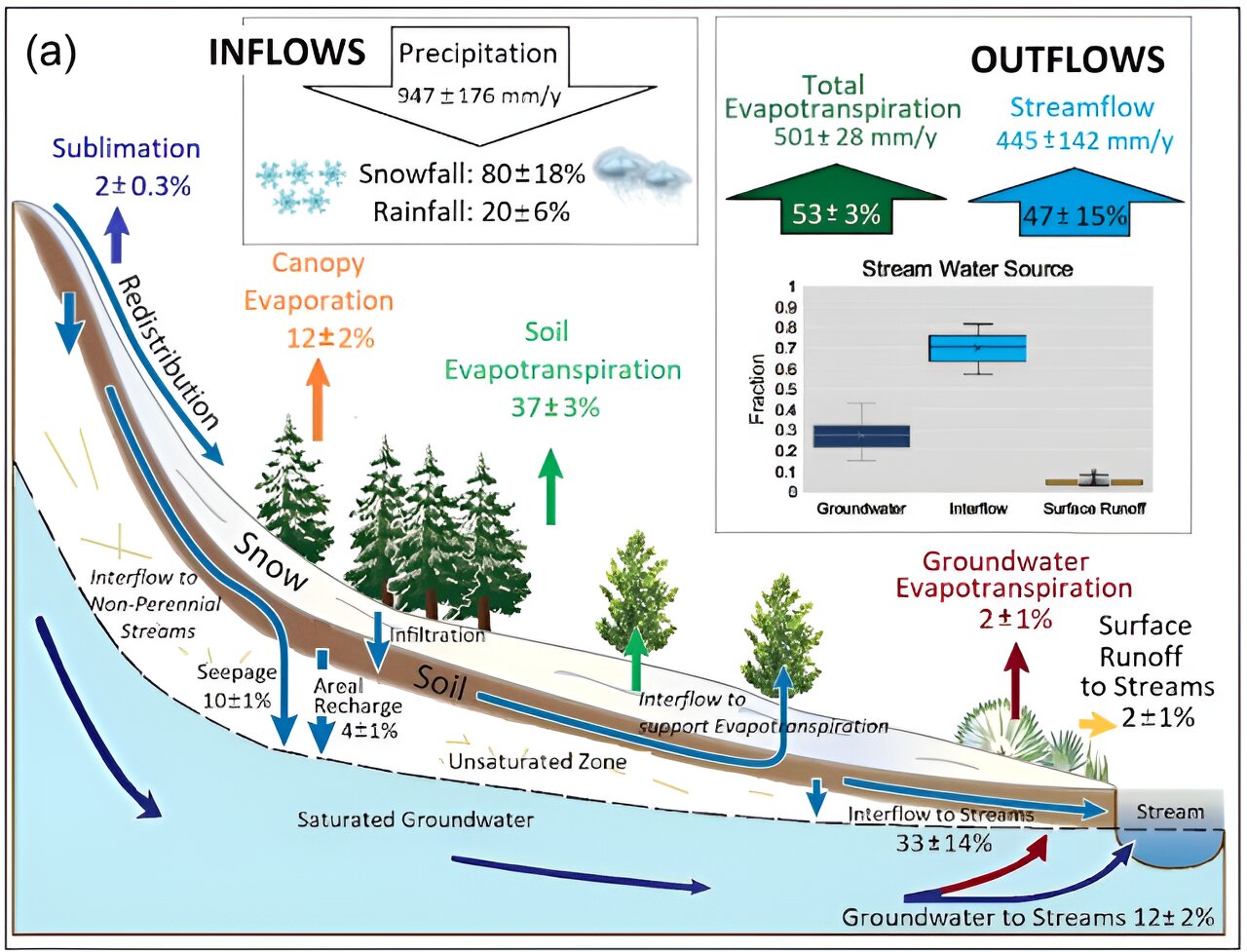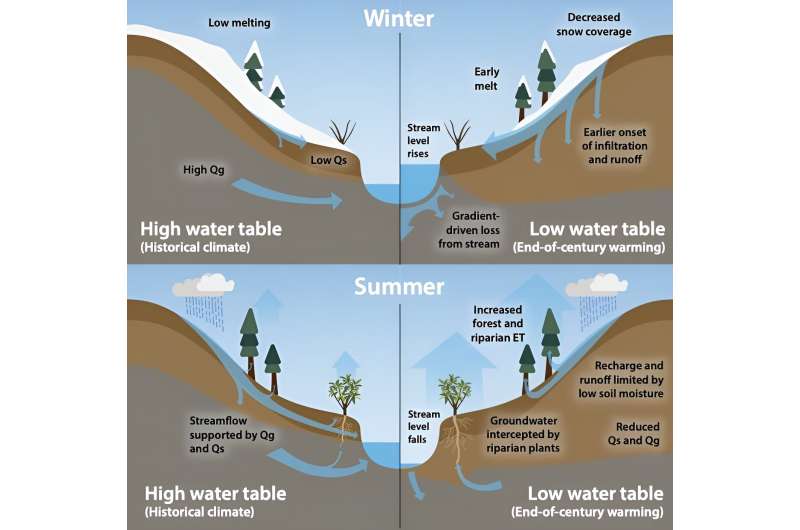Colorado
Climate change will reduce streamflow in the upper Colorado river basin as groundwater levels fall, study finds

The Colorado River makes life possible in many Western cities and supports agriculture that sustains people throughout the country. Most of the river’s water begins as snowmelt from the mountainous watersheds of Colorado, Utah, and Wyoming, and a warming climate will drastically reduce these streamflows, new research finds.
Researchers from Desert Research Institute (DRI), USGS, and Lawrence Berkeley National Laboratory teamed up for the new study, published May 23 in Nature Water.
By applying warming to historical conditions for the East River in Colorado and using computer simulations to observe the impact on streamflow and groundwater levels, the scientists found that groundwater storage would fall to the lowest known levels after the first extremely dry year and fail to recover even after multiple wet periods. When groundwater levels fall, streamflows are drawn into the water table instead of contributing to Colorado River flows.
“We found that groundwater matters a lot,” says Rosemary Carroll, Ph.D., DRI research professor of hydrology and lead author of the study. “Even with historically observed wet periods in the model, the groundwater can’t come back from a single dry water year under end-of-century warming.”
The Colorado River has been in a drought state for decades, creating tensions around water rights throughout the Southwest. Scientists have been perplexed by falling river levels even in relatively wet years—in 2021, the Upper Colorado River Basin reached 80% normal snowpack but delivered only 30% of average streamflow to the river.
The study authors wanted to examine how warming in mountain basins may be contributing to this phenomenon. Increased temperatures alter the balance between snowfall and water availability in a number of ways, including more snow evaporation (known as sublimation), more precipitation falling as rain instead of snow, and more frequent melting throughout the winter.
Past research has largely overlooked the role of groundwater and how it may buffer, or intensify, streamflow loss from climate change.
“I’m very interested in the relationship of groundwater contributions to streamflow—that has been a running theme in my research for a long time,” Carroll says. “A lot of studies indicate that in the short term, groundwater release to streamflow will help buffer drought impacts, but before this study, we didn’t have any knowledge on what that would mean over the long haul.”

The study authors used the East River as the focus for the research because it is representative of the headwaters of the Colorado River, as well as the significant weather and water monitoring infrastructure available. Ground observations and airborne mapping measure snowpack depth and density, streamflow, plant cover, and groundwater levels, among many other measurements throughout the watershed.
Historical data from 1987 to 2022 was used to create the computer model. The research team then applied 4 degrees Celsius of warming to this time period in two ways: for one simulation, warming was applied constantly across time, while in subsequent simulations, warming was applied to each season independently.
The approach allowed the scientists to examine the differing impacts of warming between seasons. Four degrees Celsius is representative of the projected climate at the end of the century based on observed warming of approximately 0.4 degrees Celsius per decade in the watershed. The simulation doesn’t account for likely changes in vegetation over the same timeframe.
The study showed that consistently warmer temperatures resulted in sharp declines in groundwater levels that were unable to recover to historical average levels during wet periods. Isolating the warming seasonally demonstrated the strong impact of warmer summers on water table declines, as the atmosphere increases evaporation rates, plants increase their water uptake, and soils dry out. The largest declines in water table elevations occur in the subalpine forests where conifer forests are most dense.
“As the groundwater level drops, you lose more streamflow to the water table,” Carroll says. “When precipitation is low, the East River stops flowing for a portion of the summer. Of course, this would have dramatic effects on ecological health and agricultural irrigation.”
By including declining water table levels in the analysis, the study found that streamflow reductions nearly double when compared to simulations that examined the impacts of climate change in the region without accounting for groundwater declines. This is because of the multiple impacts occurring simultaneously: less water flows to streams from the aquifers, while more stream water drains into the soil.
The research demonstrates the need to jointly manage forest and groundwater in the Upper Colorado River Basin, as well as account for the exchange of surface and groundwater in mountain basins, to minimize streamflow declines under climate change, Carroll says.
“I think of groundwater as your savings account,” she adds. “Snowpack is like your checking account; it changes from year to year. Groundwater is a longer-term investment—it can smooth out the really wet and dry years. But if you start consistently reducing that groundwater year after year, then you can no longer modulate those extremes.”
More information:
Declining Groundwater Storage Expected to Amplify Mountain Streamflow Reductions in a Warmer World, Nature Water (2024). www.nature.com/articles/s44221-024-00239-0
Provided by
Desert Research Institute
Citation:
Climate change will reduce streamflow in the upper Colorado river basin as groundwater levels fall, study finds (2024, May 23)
retrieved 23 May 2024
from https://phys.org/news/2024-05-climate-streamflow-upper-colorado-river.html
This document is subject to copyright. Apart from any fair dealing for the purpose of private study or research, no
part may be reproduced without the written permission. The content is provided for information purposes only.

Colorado
Five Colorado recruits to watch for 2025 and beyond – DNVR Sports

Colorado high school recruits flocked to Boulder on June 6th to participate in the University of Colorado’s Elite Camp. Deion “Coach Prime” Sanders and the rest of Colorado’s coaching staff spent the day meeting and coaching recruits from all over the Centennial State and awarded select standout players with scholarship offers.
After dominating the transfer portal over the last two offseasons, the 2025 recruiting class is shaping up to be the class that Coach Prime and Colorado’s coaching staff will recruit the hardest since their arrival in Boulder. While Colorado’s biggest recruiting weekend of the summer is next weekend (June 21st-23rd), multiple players in the 2025 class and beyond have emerged as potential targets for CU and spoke with DNVR about their experience at Colorado’s Elite Camp.
2025 three-star ATH Zayne DeSouza
Before last Thursday, 2025 three-star ATH Zayne DeSouza only had two scholarship offers from Washington State and Northern Colorado. Listed at 6-foot-6 and 260 pounds, DeSouza balled out at earned his first Power 4 offer directly from Coach Prime after his performance at last week’s Elite Camp.
DeSouza plays tight end and defensive end for Loveland High School but worked out as a tight end at last week’s Elite Camp. DeSouza was working with tight ends coach Brett Bartolone and the rest of the tight ends in attendance before Coach Prime pulled him aside, DeSouza told DNVR.
“I came in there with the intention of trying to get an offer and impress the coaches, especially Coach Prime. He seemed to take a liking for me, he was coaching me the whole camp. He came over, grabbed me and said, ‘Where are your parents at, I’m going to give you an official offer’,” said DeSouza.
DeSouza went to Nebraska for a camp this weekend and is planning on either attending camps at Wyoming or Kansas State after. He will also attend a game in Boulder for an official visit this fall.
2025 three-star WR Jeremiah Hoffman
Jeremiah Hoffman has visited Boulder at least three times over the last year and made yet another impression on Coach Prime and CU’s coaching staff last week. Listed at 6-foot-1 and 175 pounds, Hoffman plays wide receiver for Severance High School in Severance, CO. According to his Twitter bio, Hoffman has run a 4.5 40-yard dash and has set multiple Colorado High School state track and field records.
The speedy wide receiver out of Severance has yet to earn a scholarship offer from Colorado’s coaching staff but he was singled out by Coach Prime at last week’s Elite Camp. Hoffman is currently ranked as the 10th overall 2025 recruit out of the state of Colorado according to 247Sports.
2027 WR/TE Landon Wolny
Landon Wolny calls Glenwood Springs, CO home but plays for First Baptist Academy in Naples, FL. Last year as a freshman, Wolny had 27 receptions for 377 yards and five touchdowns in ten games. He is listed at 6-foot-4 and 205 pounds and plays wide receiver and tight end for First Baptist Academy.
Although he is only entering his sophomore year of high school, Wolny performed well enough in front of CU’s coaches to earn an official offer. “I went into [Colorado’s] camp to showcase my skills. I put everything that Coach Prime was telling me and showing me to use, balled out and got the offer,” said Wolny.
Wolny also worked under Coach Bartolone and graduate assistant Andrew Zimmer while at CU’s Elite Camp. He visited Colorado last year for their matchup with Oregon State and is expected to return to Boulder for a game and visit this season.
2026 QB Yianna Balafas
Yianna Balafas plays quarterback for Kent Denver High School in Englewood, CO and led Kent to a 9-1 season throwing for 1704 yards, completing 73% of his passes for 19 touchdowns and only four interceptions. He also had 163 rushing yards on 11 carries for another two touchdowns.
“What was really cool was how Coach Prime was there the whole time. Usually, some coaches will just show up at the beginning, say hi, leave or show up at the end but he was there the whole time,” said Balafas.
Balafas attributes his high completion percentage to his mind for the game. He will also be attending camps at Vanderbilt, Stanford and multiple Ivy League schools this summer. PrepZoneCO also listed Balafas as one of the top 2026 quarterbacks in the state.
2026 ATH Jack Offerdahl
Jack Offerdahl plays all over the field for Dakota Ridge High School but competed at CU’s Elite Camp as a defensive back. Listed at 6-foot and 180 pounds, Offerdahl was Dakota Ridge’s third-leading tackler in 2023 with 80 total tackles. He also had 12 passes defended and three interceptions. Offerdahl also returns kicks and punts and led Dakota Ridge in return yardage, punt return yardage and return attempts.
He is the younger brother of current Colorado running back Charlie Offerdahl and shows an identical work ethic and drive in his play and demeanor. “I was disappointed with how I performed, I was hoping to perform well enough to earn an offer but Coach Mathis picked me as one of the top 5 DB’s at the end so I must have done some good things,” said Offerdahl.
Offerdahl also told DNVR that he would be highly interested in returning to Colorado for more visits.
Colorado
Colorado fire crews respond to roof collapse at Bradford Auto Body in Littleton

South Metro Fire Rescue and the Little Police Department say personnel responded to a roof collapse at Bradford Auto Body in Littleton.
SMFR says approximately 30’x30′ portion of the building collapsed and there are multiple crews currently on the scene, including the Technical Rescue, HazMat 38 and Heavy Rescue teams to shore the remaining portion of the roof.
No one was reportedly in the building at the time of the collapse and the incident didn’t affect the Mile High Hook & Ladder Fire parade & muster that’s taking place just a block away, according to fire officials.
CBS News Colorado will continue to provide updates on this incident.
Colorado
Efforts to build an “airport city” called Colorado Aerotropolis are now official

After years of discussions and planning, a metro-area partnership has declared efforts to build out an aerotropolis — an airport city — around Denver International Airport officially off the ground.
The group of elected officials and staffers from cities, Adams County, Denver and the airport are elevating their plans to turn undeveloped areas around DIA into a hub for commerce, a magnet for innovative enterprises and an even more powerful economic engine for metro Denver and Colorado.
A website for Colorado Aerotropolis pitches the region to “makers and manufacturers, builders and developers.” At the heart of the appeal is DIA, the third-busiest airport in the U.S. and the sixth-busiest in the world.
And another big selling point is that the Denver airport, which opened in February 1995 on land annexed from Adams County, is its location: surrounded by thousands of acres of undeveloped land, not in the middle or on the edges of a dense cityscape.
“Frequently airports are built in areas that are already quite populated and that’s going to be somewhat limiting,” said Jenni Hall, director of Adams County’s Community and Economic Development.
“Denver International Airport is the second largest in terms of land mass in the world,” said Ken Cope, senior vice president of real estate development at DIA. “We have that luxury of having a very large canvas to paint on.”
The Aerotropolis Regional Committee is made up of representatives from Adams County; the cities of Aurora, Brighton, Commerce City, Federal Heights and Thornton; the City and County of Denver; and DIA. Members first signed a marketing agreement about eight years ago, said Adams County Commissioner Emma Pinter.
“The official launch is a formal way of announcing to the globe that the aerotropolis around DIA is open for business. There are parcels in every one of our jurisdictions that are for sale and ready for development,” Pinter said.
An aerotropolis is designed to place cities around a central airport, leveraging the connectivity that air travel provides. Hall said there are about 16 such developments around the world. A public-private partnership is behind an aerotropolis in Atlanta, home to the Hartsfield-Jackson Atlanta International Airport, the world’s busiest.
“The notion of an aerotropolis is one that is much more acceptable in foreign markets,” Cope said.
The model of building around an airport is something the U.S. is just starting to embrace, Cope added.
The concept encountered turbulence early on in Colorado. Adams County said Denver’s initial visions for developing the area violated the 1988 agreement on Denver’s annexation of the land.
The intergovernmental agreement that cleared the way for construction of DIA, which replaced Stapleton International Airport in Denver, was amended in 2016.
“In that amendment there was a committee that was formed to promote regionalism and development in the area,” Cope said. “But land development takes time.”
Pinter, Hall and Cope all said the regional committee has focused on collaboration among the different entities.
“I now think we’re at a point where jointly between Adams County, the airport and surrounding municipalities, we’re ready to accelerate development,” Cope said. “We’re working jointly to make sure that development is cohesive, that you’ve got the right infrastructure in place.”
The regional committee’s current budget is $1.03 million, with half coming from the airport and half from the other members of the regional committee.
The kinds of businesses the committee believes are naturals for the area include ones in such sectors as agriculture, biomedical, quantum computing, energy, advanced manufacturing and transportation. The committee’s talking points include the area’s renowned colleges and research facilities, educated workforce and the 28 international nonstop destinations served by DIA.
A study released in 2023 said that DIA’s total economic contribution to Colorado’s economy was about $36.4 billion. The airport can help drive further business opportunities and compatible development near the airport and also in the region, Phil Washington, the airport’s CEO, said in a statement.
Pinter noted that the area generally encompassing the aerotropolis contains all the state’s intersecting highways, including Interstates 70, 25 and 76.
“We also have rail lines that serve all sides of the aerotropolis,” Pinter said. “Whether you’re moving goods by rail, highway or air, this is a central location for businesses to locate.”
Aurora Mayor Mike Coffman said in a statement that Colorado Aerotropolis will provide companies direct access to such “current powerhouses” as like the Gaylord Rockies resort and convention center, the Fitzsimons Innovation Community and the Anschutz Medical Campus.
The Aurora Highlands housing development, which held its grand opening in 2023, is in the planning area.
Hall said the region also is part of a designated foreign trade zone, which provides specific tax and customs advantages for the global movement of goods.
When Cope thinks about the aerotropolis, he envisions an entire city taking shape. He said there’s an opportunity to build something similar to the existing metro area.
Denver annexed 53 square miles, or 34,000 acres for DIA. The airport has six runways and has been approved for 12.
“Even after we build all 12 of those runways, there are about 16,000 acres left that the airport will own for commercial development,” Cope said.
Get more real estate and business news by signing up for our weekly newsletter, On the Block.
-

 News1 week ago
News1 week agoIsrael used a U.S.-made bomb in a deadly U.N. school strike in Gaza
-

 World1 week ago
World1 week agoFrance to provide Ukraine with its Mirage combat aircraft
-

 World1 week ago
World1 week agoWorld leaders, veterans mark D-Day’s 80th anniversary in France
-

 World1 week ago
World1 week agoRussia-Ukraine war: List of key events, day 833
-

 News1 week ago
News1 week agoNonprofit CFO Accused of 'Simply Astonishing' Fraud
-

 Movie Reviews1 week ago
Movie Reviews1 week agoInsane Like Me? – Review | Vampire Horror Movie | Heaven of Horror
-

 Politics1 week ago
Politics1 week agoGeorge Clooney called White House to complain about Biden’s criticism of ICC and defend wife’s work: report
-

 Politics1 week ago
Politics1 week agoNewson, Dem leaders try to negotiate Prop 47 reform off California ballots, as GOP wants to let voters decide




















